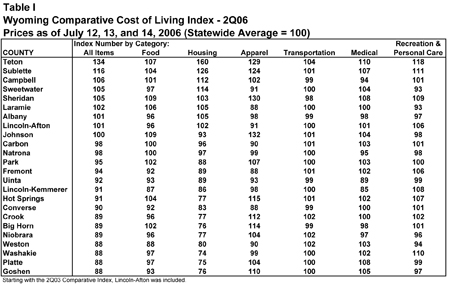|
Sublette Examiner Volume 6, Number 30 - October 19, 2006 brought to you online by Pinedale Online Sublette still second most expensive place to live in Wyoming Southwestern Wyoming residents in areas such as Sublette County have incurred the highest rate of inflation for the second quarter of 2006. Sublette County is the second most expensive county to live in, according to the recently released Wyoming Cost of Living Index. While Teton County continues to hold its top spot as the most expensive county to live in statewide, the gap between Teton and Sublette is narrowing, with the index rate separated by just 3 percentage points in the areas of food, transportation and medical expenses, five points in apparel and 24 percentage points separating housing rates. According to the report, the Wyoming Cost of Living Report not only ranks counties from most to least expensive and reports inflation rates from year-ago levels, it can be used as an economic indicator. “In general, counties that are slotted near the top of the comparative index are also currently enjoying strong local economic growth. Much of this growth can be attributed to significant mineral-related activity,” said Justin Ballard, senior economist with the State Economic Analysis Division. “Other indicators that confirm strong economic growth from mineral-impacted locations include low unemployment rates, positive employment growth, and healthy sales and use tax collections.” Statewide, Wyoming’s rate of inflation was recorded at 5.6 percent, while nationally, the inflation rate from June 2005 to June 2006 was 4.3 percent, as reported by the U.S. Department of Labor, Bureau of Labor Statistics. Overall, statewide inflation continues to report annual rates not seen this consistently high since the early 1980s, according to the release. “Not only are Wyoming consumers experiencing higher prices due to increased demand for goods and services statewide, firms are also passing along higher prices they have seen due to increased energy costs,” Ballard said. “With national inflation, as measured by the Consumer Price Index, above Federal Reserve target levels, Wyoming consumers are not only affected by many of the same factors experienced by the rest of the nation, but also by the unique factors of a mineral-driven economy during a time of higher energy prices.” Long-term national inflation is expected to return to levels that are below 3 percent. “Wyoming-specific inflation is expected to remain higher than the national levels until the housing shelter supply can catch up with demand, particularly in the more populated areas of Wyoming,” Ballard stated. “Also, a significant downturn in the energy sector would lead to a drop off in housing and overall costs in the state.” According to the release, the inflation rate represents the percent change in the price level of a standard basket of selected consumer items priced this quarter, compared with the price level of the same goods recorded one year ago. The southwest region of the state, including Kemmerer and Afton in Lincoln County, Sublette County, Sweetwater County and Uinta County, tops the rate of inflation at 7.6 percent while the northeast region of Campbell, Crook, Johnson, Sheridan, and Weston counties felt the second highest inflation rate at 6.2 percent. “As long as the mineral-related industries continue to dominate Wyoming’s economic landscape, counties that are affected by this activity will remain near the top of the comparative index,” Ballard said in the report. The most influential factor contributing to this situation is tight housing shelter markets in affected communities. The index listed average rental prices sampled from Pinedale at a rate of $781 for an apartment, compared to $699 in the same quarter last year. Mobile home lot rentals also rose more than 10 percent, from $265 to $240. But housing rentals had the greatest increase at more than 35 percent from an average house rental in the second quarter of 2005 at $882 to $1,195 to the same quarter in 2006. “Not only are shelter rates in mineral counties relatively higher, the weight they are assigned to the average consumer’s budget is the highest,” noted Ballard. “This makes shelter rates an important determining factor for the overall cost-of-living ranking.” Shelter was not alone in its rising inflation, as all areas reported rising rates as, statewide, transportation has felt the biggest hit in inflation at a rate of 7.9 percent, followed by housing with at 6.9 percent. But food and recreation or personal care had the lowest rates of inflation at a rate of 2 percent. “Due to the passage of legislation eliminating the sales tax on most food-related items purchased at a grocery store, food-related inflation was tempered somewhat in the second quarter of 2006,” Ballard noted. “The same will be true for the fourth quarter of 2006 WCLI report.”
See The Archives for past articles. Copyright © 2002-2006 Sublette Examiner All rights reserved. Reproduction by any means must have permission of the Publisher. Sublette Examiner, PO Box 1539, Pinedale, WY 82941 Phone 307-367-3203 examiner@wyoming.com |

